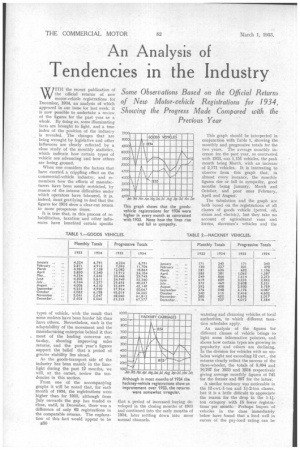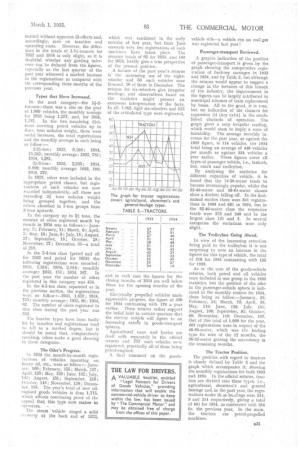An Analysis of
Page 44

Page 45

If you've noticed an error in this article please click here to report it so we can fix it.
Tendencies in the Industry
Some Observations Based on the Official Returtm of New Motor-vehicle Registrations for 1934, Showing the Progress Made Compared with the Previous Year
WITH the recent publication of the official returns of new motor-vehicle registrations for December, 1934, an analysis of which appeared in our issue for last week, it is now possible to undertake a review of the figures for the past year as a whole. By doing so, some illuminating facts are brought to light, and a true index of the position of the industry is revealed. The changes that are being wrought by legislative and other influences are clearly reflected by a close study of the monthly statistics, which indicate how certain types of vehicle are advancing and how others are losing ground.
When one considers the factors that have exerted a crippling effect on the commercial-vehicle industry, and remembers how the efforts of manufacturers have been sorely restricted, by reason of the intense difficulties under which operators have laboured, it is, indeed, most gratifying to find that the figures for 1934 show a clear-cut return to more prosperous times.
It is true that, in this process of re-. habilitation, taxation and other influences have benefited certain specific
types of vehicle, with the result that some makers have been harder hit than have others. Nevertheless, such is the adaptability of the movement and the manufacturing enterprise behind it that most of the leading concerns are, to-day, showing improving sales returns, and the past year's figures support the belief that a period of greater• stability lies ahead.
As the goods-transport side of the industry has been mainly in the limelight during the past 12 months, we will, at the outset, review the tendencies in this section.
From one of the accompanying graphs it will be noted that, for each month of 1934, the registrations were higher than for 1933, although from July onwards the gap has tended to close, until, in December, there was a difference of only 62 registrations in the comparable returns. The explanation of this fact would appear to be 1330
This graph should be interpreted in conjunction with Table 1, showing the monthly and progressive totals for the two years. The average monthly increase for the past year, as contrasted with 1933, was 3,151 vehicles, the peak month being March, with an increase of 2,171 vehicles. It is interesting to observe from this graph that, in almost every instance, the monthly figures rise or fall in sympathy, good months being January, March and October, and poor ones February. April and August.
The tabulation and the graph are both based on the registrations of all classes of goods vehicle (petrol, oil, steam and electric), but they take no account of agricultural vans and lorries, showmen's vehicles and the watering and cleansing vehicles of local authorities, to which different taxation schedules apply.
An analysis of the figures for different classes of vehicle brings to light some informative pointers, and shows how certain types are growing in popularity and others are declining. In the division for vehicles with an unladen weight not exceeding 12 cwt., the' returns clearly reflect the success of the three-wheeler, the totals of 8,894 and 10,767 for 1933 and 1934 respectively giving average monthly figures of 741 for the former and 897 for the latter.
A similar tendency was noticeable in the 12-cwt.-1-ton and 14-2-ton classes, hut it is a little difficult to appreciate the reason for the drop in the 1-11ton category with 18 fewer registrations per month: Perhaps buyers 'of vehicles in the class immediately below have found that a load well in excess of the pay-load rating can be
carried without apparent ill-effects and, accordingly, save on taxation and operating costs. However, the difference in the totals of .1-1k-tonners for 3933 and 1934 15 only slight, so it is doubtful whether any guiding inference can be deduced from the figures, especially as the last quarter of the past year witnessed a marked increase in the registrations as compared with the corresponding three months of the previous year.
Types that Have Increased.
In the next category-the 1i-2tonners-there was a rise on; the year of 1,689 vehicles, the monthly average for 1933 being 1,257, and, for 1934, 1,381. In the two remaining divisions covering petrol vehicles up to three tons unladen weight, there were useful increases, the total registrations and the monthly average in each being as follow ;
2-2k-ton : 1933, 9,884; 1934, 15,383; monthly average : 1933, 782; 1934, 1,281.
21-3-ton: 1933, 2,235; 1934, 3,359; monthly average: 1933, 186; 1934, 279.
In 1933, oilers were included in the appropriate petrol classes, but registrations of such vehicles are now recorded independently, all those not exceeding 2k tons unladen weight being grouped together, and the others classified in 1-ton groups from 3 tons upwards.
In the category up to 21 tons, the number of oilers registered month by month in 1934 was as follows :-January, ; February, 11; March, 6; April, ; May, 10; June, 8; July, 18; August, 27; September, 18; October, 28; November, 37; December, 33-a total of 210.
In the 3-4-ton class (petrol and oil for 1.933 and petrol for 1934) the following registrations were recorded: 1033, 1,816; 1934, 2,014; monthly average: 1933, 151; 1934, 167. In the past year the number of oilers registered in this category was 434.
In the 4-5-ton class, separated as in the previous section, the registrations were as follow :-1933, 1,033; 1934, 755; monthly average : 1933, 86; 1934, 62. The number of oilers registered in this class during the past year was 552.
The heavier types have been badly hit by taxation and registrations tend to fall to a marked degree, but it should be noted that, comparatively speaking, oilers make a good showing in these categories.
The Oiler's Progress.
In 1934 the month-by-month registrations of vehicles operating on heavy oil, etc., were as follow :-January, 160; February, 155; March, 157; April, 125; May, 132; June, 132; July, 143; August, 151; September, 119; Oetober, 148; November, 138; December, 155, The year's total of new oilengined goods vehicles is thus 1,715, which affords convincing proof of the appeal that this type now makes to
operators. •
The steam vehicle staged a mild rerevery at the back end ef 1933,
which was continued in the early months of last year, but from June onwards very few registrations of such machines have taken place. The steamer totals of 62 for 1933, and 140 for 1934, hardly give a true perspective of the present position.
A feature of the past year's returns is the increasing use of the eightwheeler and 50 such vehicles were licensed, 10 of them in December. The returns for six-wheelers give irregular readings, and observations based on the statistics might present an erroneous interpretation of the facts. In all. 1,621 rigid six-wheelers and 833 of the articulated type were registered, and in each case the figures for the closing months of 1934 are well below those for the opening months of the year.
Electrically propelled vehicles made appreciable progress, the figure of 369 for 1934 contrasting with 170 a year earlier. These returns rather support the belief held in certain quarters that the electric vehicle will _figure to an increasing exteak in goods-transport spheres.
Agricultural vans and lorries are dealt with separately in the official returns and .757 such vehicles were registered, practically all of them being' pet rol-engin ed.
A final comment on the goods Passenger-transport Reviewed.
A graphic indication of the position of passenger-transport is given by the graph showing the comparative registration of hackney carriages in 1933 and 1934, and by Table 2, but although the returns would appear to suggest a change in the fortunes of this branch of the industry, the improvement in the figures can be largely attributed to municipal schemes of tram replacement by buses, All to the good, it is true, but no indication of the chances for expansion (if they exist) in the established channels of operation. The graph gives a very irregular reading, which would seem to imply a state of instability. The average monthly increase for the past year, as against the 1933 figure, is 114 vehicles, the 1934 total being an average of 448 vehicles per month as against 334 'vehicles a year earlier. These figures cover all types of passenger vehicle, taxicab, bus, coach and trolleybus.
By analysing the statistics for diflerent capacities of vehicle, it is found that the 14-20-seater tends to become increasingly popular, whilst the 32-40-seater and 56-64-seater classes show a distinct falling off. In the firstnamed section there were 541 registrations in 1933 and 681 in 1934, but in the 32-40-seater class the respective totals were 373 and 240 and in the largest class 121 and 2. In several categories the variations were only slight.
The Trelleybus Going Ahead.
In view of the increasing attention being paid to the trolleybus it is not surprising to note an increase in the figures for this type of vehicle, the total of 218 for 1934 contrasting with 135 for 1933.
As in the case of the goods-vehicle returns, both petrol and oil vehicles were included in one group in the 1933 statistics, but the position of the oiler in the passenger-vehicle sphere is indicated in the monthly returns for 1934, these being as follow:-January, 33; February, 24; March, 73; April, 35; May,119; June, 129; July, 151; August, 108; September, 81; October, 60; November, 110; December, 107. Out of this total of 1.030 for the year, 463 registrations were in respect of the 48-56-seater, which was the leading type for nine of the 12 months, the 26-32-seater gaining the ascendency in the remaining months.
The Tractor Position.
The position with regard to tractors is clearly defined by Table 3 and the graph which accompanies it, showing the monthly registrations for both 1933 and 1934. In the official returns, tractors are divided into three tyl.es, i.e., agricultural, showmen's and general haulage and, in the past year, the registrations under th,se headings were 244, 3 and 214 respectively, giving a total of 461 for 1934, as contrasted with 354 fo_ the previous year. In the main, the tractors are petrol-propelled machines.




























































































